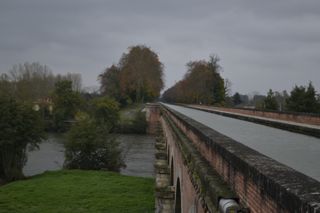The French love ‘Grand Projects’, and I love them for it. Everytime I see a TGV-train, I have to mention it to Julie. I just love the slender form of the trains. And all the time I am asking myself, are they really going 300 km/hr (180 mph). I remember myself as a teenage youngster cycling over to the first TGV track and waiting for at least 30 minutes just to see one train pass by in a few seconds. My brother in law Peter and his children will appreciate this revelation, Hellen has become a train-addict too by the way, but it is nuttiness, of course. But then again, all these speedy trains crisscrossing the country seem a sign of healthy progress to me.
What other grand projects do I like. Centre Pompidou, although the destruction of Les Halles is a crime. The I.M. Pei Pyramid at The Louvre; the Arc the Triomphe office building in La Defense in Paris; the Bibliotheque Nationale in which the office buildings take the form of a book. Spectacular, Grand Scale, and crazily expensive.
These examples are recent – the last half century, but the French have been in the habit of thinking Grande for some time. I realized that when we were passing Le Canal du Midi on our way to Toulouse a few days ago. It is a canal built in the 18th century, joining the Atlantic Ocean to the Mediterrenean. In order to do that only a channel had to be dug between Toulouse and La Mediteranee, because the river La Garonne provided for the Toulouse-Bordeaux-Atlantic Ocean track. Pierre Paul Riquet, according to our camping friend Benedict a true genius on the same level as Gustave Eiffel, came up with the plans.
But the plan was so crazily expansive that Colbert, the secretary of finance under Louis XI – and one of the groundlayers of the economic profession, did not even want to consider it and joked laughingly about ‘Riquet’s ditch’ when he referred to the plans.
But secretary’s of finance weren’t almighty in 18th century France, as I do suspect they are still not in present day France. Anyway, Louis XIV loved the idea and gave Riquet free spending power in order to achieve his dream. Which he did, in only fifteen years. Mountains were, literally, moved in order to make his dream possible. It was called the Eight Wonder of the World (which made me think what were the other seven?) at the time and still dazzles the mind, also because since finishing it in 1785, some of the then planted trees have grown to three centuries old pieces of art by themselves.
It was an enormous stimulus to trade in the region, be it a propably undefensable expensive one, but these days the canal is too small for professional trade. But it is still fashionable with tourists, it seems.
I enjoyed the glimpses of the Canal, and of the trees, on our way here. Today we decided to take a rest at Moissac, the place of some some splendid scupture at its Romanesq church. But there also was a bridge that helped boats pass a river. You are reading this well. In Holland we build bridges for badgers to go from one side of the motorway to the other, which seems extravagant, but at least one can assume that the badgers would die if they would have to pass the motorway by their own feet.
But a water bridge for boats just so they can pass a river??? I thought of my old TGV times and waited for 30 minutes. Not one boat passed, not on the canal as on the subsequent Garonne river. Which made me think French are nuts. But I marvel at it too. It was a beautiful bridge too. With lovely still water. It would have been a crime for a boat to disturb its peacefulness.
19 nov

Share


Han says
Taking the risk being a smarty: it’s called an aquaduct, Joost. You’ll find them throughout Europe. Somewhere in eastern France there must be a crossing of canals, can’t remember exactly where.